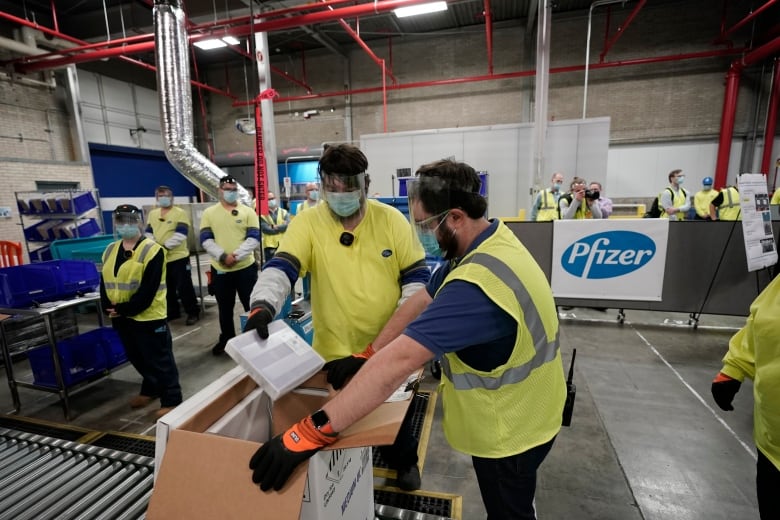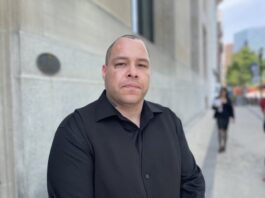
Dr. Joanne Langley is a pediatric infectious disease physician and a professor in the departments of Pediatrics and Community Health and Epidemiology at Dalhousie University. Since last spring, she also has been co-chair of the task force that has been advising the federal government on COVID-19 vaccine procurement.
Interruptions in deliveries of vaccine doses to Canada have led to a tense debate about the Liberal government’s handling of the issue. Langley has been invited to speak the health and industry committees of the House of Commons later this month, but she spoke to CBC News this week about her role and how she sees Canada’s situation.
Langley says task force members were assembled by the federal government in late May and early June of last year. The task force then began to evaluate the scientific, technical and logistical merits of potential vaccine suppliers.
The following transcript has been edited for clarity and length.
Q: Who are the candidates at that point?
A: So there were two strains. There was domestic and international. For the domestic, ISED [Innovation, Science and Economic Development Canada] put out a call to any company for Strategic Innovation Fund [SIF] proposals. So there were, I think, 22 submissions to SIF from Canadian sites. And so we reviewed all of those. That was how we knew what was the potential in Canada.
We also did a more proactive review, and there was a vendor that went and basically tracked down every single company in Canada that had anything to do with vaccines, drugs, biologics, and looked at what their capacity was. We reviewed all those under this rubric. We had meetings with the proponents. ISED did due diligence on them.
We had particular questions that we would want answered. And then we made recommendations to ministers about those products. And we only speak about the ones that received funding because if they didn’t receive funding for their own benefit, those are confidential.

And then internationally, what we did was basically track down around the world what vaccines were in what phase. So the WHO [World Health Organization] quite early on started tracking every single vaccine and what phase it was in. And so we reviewed those proponents and determined what [were] the most likely ones that were going to deliver a vaccine in 2021 — at that time, I don’t think we thought we’d have a vaccine by December of 2020.
And then we reached out to them and had meetings with them again and asked some questions in order to satisfy ourselves that they had scientific and technical merit, and also inquired about opportunities for partnering with Canadian universities or businesses or governmental scientists, or any possibility of bringing something here to Canada, rather than just buying the product …
Q: And was it the task force that came up with this approach of diversifying Canada’s purchases and going to seven different suppliers?
A: Yes, we recommended a portfolio. And there’s a number of different platforms. All of the vaccines we recommended fell into one of three platforms.
Q: A lot of attention is now on this question of domestic capacity and domestic manufacturing. Can you explain why … we didn’t end up with domestic manufacturing of vaccines?
A: I think we are going to have domestic bio-manufacturing of vaccines. So Medicago will ultimately be on Canadian soil. Novavax is another one. There are other announcements that will, I’m sure, be made in the coming weeks. But there is quite a strong bio-manufacturing strategy that has been determined and will unfold.

Q: The question that seems to get posed is, why don’t we have domestic manufacturing up and running right now? Why didn’t we pursue some kind of domestic manufacturing that would be up and running right now?
A: Okay, so that would be over a period of, say, August until now, about six months. The NRC [National Research Council] buildout started in the fall. So it started within months of these task forces being built.
These are not manufacturing processes that can be built in a month or two, or three or four or five or six, even. Some of them have to be explosion-proof. Some rooms have to be sterile. You have to have the highly qualified personnel who can do the tech transfer, who can receive the training and then demonstrate that they can produce the vaccine. These are processes that are very, very meticulous and have extremely high standards. And Health Canada, the regulator, is testing the batches that you’re producing.
These are biologics processes. If you had a farmer growing something in a field, you can’t just say, ‘Well, could you just grow that faster, please?’– Dr. Joanne Langley
So to get that kind of whole process of building a plant, getting the machinery in place, getting the highly qualified personnel to make the vaccine and then scale it up, fill and finish it and deliver it out and pass regulatory approval — that wouldn’t be able to be done in the period from, you know, August to January. But the NRC proposal was ultimately approved and they have started. The Medicago plant was already starting to be built at the beginning of the pandemic, so they just continued that.
I think the overall story is that there was effort put towards bio-manufacturing. It’s not something that happens on the turn of a dime. And my colleague Alan Bernstein had a very good kind of simile … Say that you were invited to dinner and you spent the entire day making this dinner for your two friends and you salted it perfectly and the right amount of turmeric, all these things. You know, it was in the oven for three minutes, not four, and after the meal, they say, “OK, this is just perfect. Can you make exactly the same thing for a thousand people two days from now?”
You know, these are biologics processes. If you had a farmer growing something in a field, you can’t just say, “Well, could you just grow that faster, please?” It’s not realistic to think that you could in a month or two have one of these huge bio-manufacturing plants up and running.
Q: One of the examples that gets cited is the United Kingdom, and the question of whether Canada could have expanded capacity or set up capacity as fast as they seem to have. Does that seem like a realistic possibility to you?
A: Well, the presumption there is that the U.K. didn’t have capacity. They already had several manufacturing plants for international vaccines. So it’s not true that they started from zero. That is really one of the myths that is circulating. They did accelerate what they were doing and they added capacity, but they already were producing huge amounts of vaccines.

Q: In hindsight, is it possible that if the task force had gotten started even earlier … in March or February or January of last year, that Canada would be in a different place right now?
A: I suppose anything’s possible. It’s hard to say. I think we worked as hard as we could at the time we started our work together. I think someone tallied up and we had like 400 hours worth of meetings in the first few weeks because there was just such a sense of urgency.
And I really can’t speak to what is really kind of imaginary, to think of what might have happened had we met earlier. There certainly wouldn’t have been any data to review if we’d started in March because the first vaccine was the Moderna and they started [Phase I trials in March].
Certainly there was no idea that it was going to be our Canadian vaccine. It was just one of many international candidates …– Dr. Langley on the CanSino project
Q: One of the other things that’s been given a lot of attention is the CanSino project. Was that a significant setback for Canada? In addition to obviously falling through, did it distract or detract from the larger effort to get a vaccine?
A: My personal view would be that it was one of the vaccines that was evaluated, just like all the other international candidates. It wasn’t higher on the priority list. Every potential vaccine candidate was reviewed. So it wasn’t — certainly there was no idea that it was going to be our Canadian vaccine. It was just one of many international candidates that we looked at with scrutiny.
Q: In the last little while, a couple of companies have come forward and said, “We could help, or we could have helped.” Providence being one, PnuVax being the other. Is it possible to say why you didn’t recommend going with those options?
A: So as I said, anyone who submitted a request to the SIF Fund, if they were funded, then that information is public. But some of the information is confidential. And some of those people that proposed applications to ISED — I can’t say things about them that are confidential. So we only speak of the ones that were highly ranked and that were funded ultimately.
Q: Is it possible to say what was decisive about the domestic ones that you did go with?
A: I would say it’s multi-factorial. So really, they had to tick off a lot of boxes of having a good product that in all the data that they presented to us looked like it would be effective against the virus, that would induce an immune response, that would be safe for the host. That they had the experience with clinical development of vaccines or could benefit by partnering very quickly with other people who had that capacity that could scale up their product. That they were a financially stable company. And all of those things were looked at.
We wouldn’t have taken something that could scale but that wasn’t safe and effective, or that was safe and effective but there was no chance that you could make that vaccine in sufficient quantity. So really, all of those aspects were considered for every vaccine.

Q: Procurement Minister Anita Anand has said that she went to the international suppliers that the government ended up signing contracts with and asked whether they would be interested in domestic manufacturing in Canada and that, in every case, they essentially said it wasn’t possible. Should that surprise us?
A: What the minister has said … is consistent with that strategy, that we would look for that in every instance, to see where we could partner with Canadian scientists or businesses or could they even just fill and finish on our soil.
So there are many considerations for these vaccine companies. Ultimately, they have a responsibility to deliver a product and they have timelines they must abide by. They’re making vaccines — ultimately, most of them — for one or two billion people.
So there is a lot of effort if you don’t have a plant all ready to go that could produce that volume of vaccines that you need to consider when you’re thinking, “Should I make this partnering agreement?” So all those things would be considered by those companies and, ultimately, they may have already had agreements or they may want to use their own plant.
We had many good discussions about that. And ultimately, one is a possibility. And who knows, there may be more in the future. The story’s not completely written yet.

Q: I don’t know if this has even been suggested, but just to throw it out there — was it ever considered whether we could have somehow gotten involved with the U.S. initiative Operation Warp Speed?
A: I think one would have to consider whether at the time of the previous administration, there would be interest in partnering with other countries to make vaccines for Canadians.
Q: Can you say whether it was considered?
A: We looked at everything. We met with task forces in the U.K. and New Zealand, Australia, just to share ideas. We also met with some folks from Germany. So our thinking was not boxed in. We were being very creative, as were the ministries who were helping us, trying to create opportunities and do things in a new way. So I would say there was hardly anything that wasn’t considered.
Q: In the latest rankings, we were something like [39th] in vaccinations per capita. How should Canadians feel about that? Is there an explanation in your mind for why we’re at where we’re at?
A: So the immunization rollout is a provincial-territorial responsibility. I think at this point they’ve probably delivered all the vaccines that are available. But some provinces are holding back the second dose so that they make sure everyone gets their doses according to schedule, which is perfectly rational. And so I think we will be getting more vaccines.
We sometimes have to wait and be patient. But making a fuss about it does not solve the problem. And making demands doesn’t solve the problem.– Dr. Langley on vaccine delivery disruptions
It’s not unanticipated that there would be stoppages to vaccine supply. For those of us that have been working in vaccine science for two decades, that is routine because these are biologic processes. The general public may be used to, well — we’re ordering cars, why can’t you just put the wheels on and the engine and what’s the delay? It is very different for vaccines and for all biologics.
So I’m not surprised that there were interruptions to the supply chain. I am assured that everyone who’s manufacturing a vaccine at this time is working 24/7 to get them out as soon as possible. So when there’s supply chain problems, my approach would be, “Okay, find out what the problem is.” And then we sometimes have to wait and be patient. But making a fuss about it does not solve the problem. And making demands doesn’t solve the problem.
Q: But Canadians may ask, “Why do we seem to have fewer vaccines than a lot of European countries? Why do we seem to be behind so many countries?” Do you have an explanation for that?
A: I would say it’s probably just due to the schedule of when the shipping occurs and the timing of it. So there’s so many multilateral contracts, plus the COVAX contracts [and] every single country’s shipping time is something that’s usually kept confidential. They don’t publish those.
And also, if you have a smaller country with a smaller jurisdiction, with a smaller geographic area, you can deploy the vaccines you get much more quickly than we can in Canada, obviously, because our population is dispersed among rural and urban locations. It’s easier to deliver vaccines when everyone’s concentrated in the same geographical area.
Q: But would you then argue that this place that Canada is in right now was sort of unavoidable?
A: I would say that there’s [nearly] 200 countries in the world and everyone deserves vaccines. And I don’t think we should be putting so much attention on who gets them first and second and third. The production line is pumping out vaccines. We will get them in due time. And at the same time that people are pointing out, “Well … that’s terrible,” other people are saying … “Why don’t we expand our view beyond our own borders to the peoples of the world who need vaccines?”
Just be content for a little bit that we are going to get enough vaccines for all Canadians by September and worry less about are we getting them today or tomorrow, and do your best to get through this pandemic without spreading disease until you get the opportunity to have a vaccine. Because right now, many people in the world do not have that opportunity to look forward to.
Q: In hindsight, do you think there was anything you, the task force, could have done differently?
A: I don’t think so. There was a lot of learning along the way. I mean, we adapted as we went. We had a process of consultation that was really marvellous, where all views are entertained. And you don’t go into the discussion with a set point of view. You may have a completely different point of view after the consultation, which was wonderful because we’re all in such different areas, we can see different aspects of each issue. We’ll continue to do that.
You know, science is changing, the evidence is changing, the portfolio might need to change, but we’re committed to doing that change. Nothing is written in stone because we know that new information might emerge. And so, I think if you have that learning attitude, you can’t really look back and say, “Well, why didn’t we do this?” We did the best we could with the information that was available.
Q: Because I’m sure you’ve noticed there is a lot of angst about the fact that Canada is not doing better. And it feels like there’s a searching for — well, there must have been something Canada could have done differently to acquire quicker or more plentiful vaccines. Does it feel to you like there’s not an obvious alternative?
It’s very difficult for any one country to solve the problem of vaccines — even the U.S., who threw so much money at this, requires supply chains from other countries.– Dr. Langley on vaccine production
A: I mean, my alternative is quite an optimistic one. And it would be a world where we looked at these issues globally. So what we had to do for this pandemic is try and figure out a solution on the spot and try and create alliances to solve problems because all countries are really interdependent.
It’s very difficult for any one country to solve the problem of vaccines — even the U.S., who threw so much money at this, requires supply chains from other countries. So if on a global level the World Health Organization or some other international agency was able to secure bio-manufacturing at the start of a pandemic plan to make 14 billion doses of vaccines — if it was a two-dose schedule — I think that could have accelerated it rather than people in each country, all 200 of us, trying to figure out how we’re going to get vaccines.
If you look at climate change, it’s the Paris Accord where everyone makes a commitment to address the problem in a way that you’ve all agreed is scientifically and socially the best path forward — then you’re more likely to solve climate change. But each country on their own cannot solve climate change. Smallpox was solved because we took a global approach everywhere. The whole world agreed to have a particular strategy for smallpox elimination. And they did that country by country by country, and we eliminated smallpox.
So that would be my answer to the question of what could we have done better. I think it’s coming. I mean, COVAX is something like that. It’s not quite there, but it’s on the path to a global approach to these issues that threaten us all.












